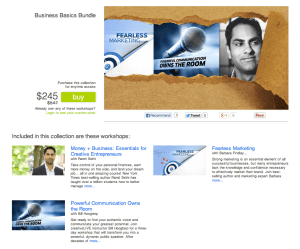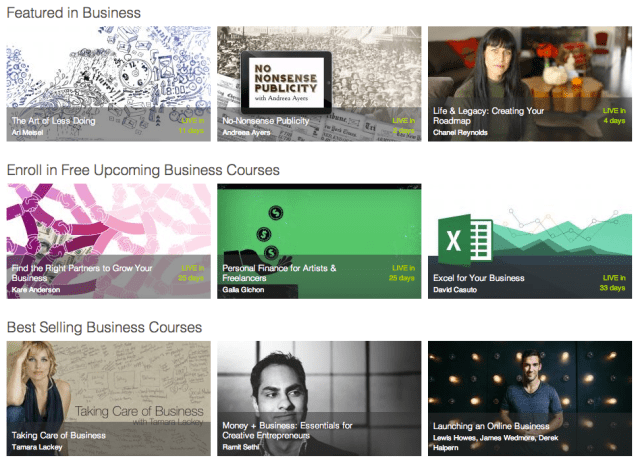Beginning with the likes of Khan Academy and Coursera, over the last two years, a new kind of learning has begun to emerge on the Web, bringing with it the promise of affordable, quality education at scale. Looking to capitalize on this fast-growing opportunity in online learning, Chase Jarvis and Craig Swanson launched CreativeLIVE in early 2010 to put a twist on the Khan-inspired, video-focused online learning model. They decided to offer their content not only for free, but totally live, while catering to a particular audience that they knew well: Creative entrepreneurs.
Since raising $7.5 million from Greylock and hiring former president of Viacom Digital, Mika Salmi, as the its CEO, CreativeLive has been growing fast. Today, with over 2 million students have consumed more than one billion minutes of CreativeLive’s skills-based learning content, CreativeLive is adding more coin to its coffers.
Over the last six months, the team has moved to scale production to keep pace with the growing opportunity in online education and content delivery, building new state-of-the-art studios to broadcast is live, online lessons. With two studios in Seattle and two in San Francisco, CreativeLive is looking to continue its expansion and ramp up its investment on the infrastructure side.
To do that, the company has raised $21.5 million of Series B financing in a round led by The Social+Capital Partnership, with participation from existing investor, Greylock Partners, and a handful of others. With this new round, CreativeLive has now raised just under $30 million in about 16 months, which new CEO Mika Salmi tells us the company will use to invest in people, technology and content.
When Salmi stepped into his new role as CEO last June, he tells us, CreativeLive had a total of eight full-time employees. Today, that number has grown ten-fold to 80 and, with its new capital, the company will look to continue that expansion, adding to its engineering and data science teams over the next year, he says.
 Furthermore, though he remained tight-lipped about details, the CreativeLive CEO said that the new investment would become part of a “major investment” the company is making in its technology and infrastructure. It seems that, with four studios (two of them new), the company decided that its time to update its front-end video architecture and player, as well as the back-end support systems that help it produce and display its content.
Furthermore, though he remained tight-lipped about details, the CreativeLive CEO said that the new investment would become part of a “major investment” the company is making in its technology and infrastructure. It seems that, with four studios (two of them new), the company decided that its time to update its front-end video architecture and player, as well as the back-end support systems that help it produce and display its content.
Today, CreativeLive has a library of over 500 courses that range across a number of subjects within the “creative” fields, with the majority of it falling into one of seven-odd buckets: Photography and video, business and money, art and design, software, audio and music and lifestyle and crafts. From the beginning, Salmi tells us, CreativeLive set out capitalize on the growing interest in and demand for online education to become the go-to resource for creative crowd.
Since then, the company has been working to build a platform around its live courses, focusing in particular on growing its library. Of the seven categories CreativeLive’s content now covers, two of them have been launched in recent months and content remains sparse as a result. The Audio and Music section now offer about five classes, for example, compared to the 150 to 200 classes one will find in photography.
Photography has been CreativeLive’s core competency since the beginning, as co-founder Chase Jarvis is a photographer himself. Over the course of years, Jarvis was able to build a sustainable and growing photography business, so part of his motivation for developing CreativeLive was to help people gain from his own experiences and to help creatives learn how to turn passions, projects and passion projects into real businesses.
The idea, Jarvis told us recently, was to offer curated content and advice from the world’s best teachers. Of course, “world’s best teachers” smacks of marketing puffery and means many different things to many different people — for Jarvis, it meant offering instruction from not just people with PhDs in Education, but those who’ve “lived what they preach,” like offering filmmaking classes from House Director of Photography, Gale Tattersall and photography lessons from Pulitzer Prize winner Vincent Laforet. You get the picture.
Admittedly, it may sound like a lot of romantic hot air, but, so far, it’s been working. Salmi attributes this to a “fragmented market” within the continuing education space. While veteran sites like Lynda.com continue to thrive, Salmi believes that the supply of quality educational content still pales when compared to the demand. Traditionally, self-help and continuing education content has been spread across a range of different sources, from workshops and extension schools to video series, tutorials and audio books.
CreativeLive self-identifies itself as a skills-based, continuing education platform and isn’t messing around with formal education — at least not yet — because the continuing education market still hasn’t crowned a winner, or even a leader. Although Lynda Weisman may beg to differ on that note. So, you won’t see CreativeLive offering certificates, a degree program or recruiting services. For now, the company is sticking to its core competency: Helping creative entrepreneurs figure out how to turn their passions into careers.
 Salmi wouldn’t rule out the possibility that CreativeLive might eventually offer some sort of credentialing system or recruiting services, and, internally, the company has already begun to think of the content in its seven main categories under a curricular template. So, then again, it may not be long before we start seeing CreativeLive serve its content in more comprehensive, curricular groups or doses.
Salmi wouldn’t rule out the possibility that CreativeLive might eventually offer some sort of credentialing system or recruiting services, and, internally, the company has already begun to think of the content in its seven main categories under a curricular template. So, then again, it may not be long before we start seeing CreativeLive serve its content in more comprehensive, curricular groups or doses.
While the company declined to share revenue numbers, Salmi says that, in spite of the fact that the company has experimented with a number of different options both in terms of payment, as well as in the length of its videos and courses, the number of teachers, type of teachers (and so on), its original model continues to serve it well. CreativeLive, for those unfamiliar, takes a “buy if you miss it” approach, offering its content for free the first time around, but if viewers want access to a recorded video to re-watch (or because they missed it the first time), they’ll have to pay.
Going forward, CreativeLive will mainly focused on completing the product and infrastructure development that’s currently in the works and should be ready by the end of the year, after which it wouldn’t be surprising to see the company turn its sights to the broader picture and begin to go international. It also still has a lot of work to do in shoring up some of the gaps in its seven categories, beginning with Audio and Music.
There’s no doubt that the company will continue to see increasing competitive pressure from veterans like Lynda.com, as well as younger players like Skillshare and Curious. By offering courses for creative entrepreneurs that are live, social and start out free, Salmi believes the company is onto the right combination and that its model offers enough differentiation and value that it can survive the competitive onslaught.
The CEO believes that, with its new capital in tow, it’s a matter of pulling the right levers. How realistic that perspective is remains to be seen, and though its fortified with enough capital to survive any potential downturns, the next year should prove whether or not the startup’s live, creative-business angle is here to stay or is just a flash in the pan.
For more, find CreativeLive at home here. and check out our TCTV interview with founder Chase Jarvis below:

